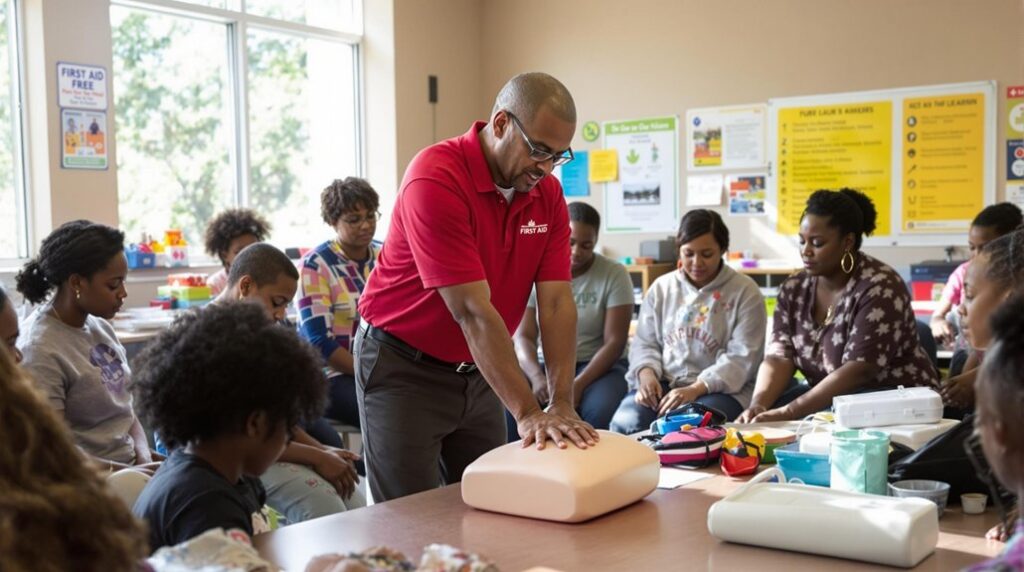Local first aid training services equip you with essential skills to handle emergencies effectively. These programs cover important techniques like CPR, wound care, and choking management. By participating in these courses, you foster a safer community and enhance your confidence in crisis situations. Choosing the right program involves checking accreditation, instructor qualifications, and course content. Effective training not only prepares you for immediate response, but it also guarantees ongoing readiness for unexpected events. More insights await you on this topic.
The Importance of First Aid Training
First aid training is crucial for everyone, as it equips you with the skills necessary to respond effectively in emergencies. Being trained in first aid can mean the difference between life and death during critical situations. You learn how to assess an injury or illness quickly, which is essential in high-pressure environments. Moreover, this training fosters confidence, enabling you to act decisively when others may hesitate. Knowing essential techniques like CPR, wound care, and the management of choking can greatly reduce complications until professional help arrives. Additionally, first aid training promotes a culture of safety and preparedness within communities. By understanding these skills, you contribute to a more resilient society, where individuals can support one another in times of crisis.
Types of First Aid Courses Offered
What types of first aid courses are available to meet your needs? You can choose from a variety of options, each tailored for specific situations. Basic First Aid courses typically cover essential skills for handling minor injuries, while CPR and AED training focus on life-saving techniques during cardiac emergencies. If you're in a workplace setting, Occupational First Aid courses address specific workplace hazards and protocols. Additionally, specialized courses like Pediatric First Aid are designed for caregivers who work with children. You might also find wilderness first aid courses that prepare you for emergencies in remote areas. Each course aims to equip you with practical skills, ensuring you're ready to respond effectively in emergencies.
Benefits of Local First Aid Training Services
Engaging with local first aid training services offers numerous benefits that enhance both personal safety and community preparedness. By participating in these programs, you gain essential skills that enable you to respond effectively in emergencies, potentially saving lives. Additionally, local training fosters a sense of community, as you connect with others who share a commitment to safety. This camaraderie can lead to improved collaboration during crises, as trained individuals often work better together. Local services also allow you to learn tailored techniques suited to your specific environment, whether it's at home, work, or in public spaces. Moreover, by investing time in first aid training, you increase your confidence and readiness, empowering you to handle unexpected situations with competence and assurance.
How to Choose the Right Training Program
When selecting the right first aid training program, how can you guarantee it meets your specific needs and circumstances? It's crucial to evaluate several factors to make certain you receive quality training. Consider the following:
- Certification: Verify that the program is accredited by a recognized organization, ensuring it meets industry standards.
- Instructor Qualifications: Research the instructors' backgrounds to ensure they have relevant experience and expertise in first aid training.
- Course Content: Review the syllabus to determine if it covers essential topics, including CPR, wound care, and emergency response.
- Flexibility: Look for programs with various scheduling options to accommodate your availability, whether in-person or online.
What to Expect During a First Aid Course
As you commence a first aid course, you'll find the experience structured to provide practical skills and theoretical knowledge that are essential for emergency situations. The training typically involves hands-on practice, simulations, and interactive discussions to reinforce learning.
Here's a quick overview of what to expect:
| Component | Description |
|---|---|
| Practical Skills | You'll learn techniques like CPR, wound care, and choking relief. |
| Theoretical Knowledge | You'll cover topics such as anatomy, emergency protocols, and legal considerations. |
| Assessment | Expect practical assessments to demonstrate your skills, ensuring you're prepared for real-life scenarios. |
This combination of learning styles equips you with the confidence and competence needed to respond effectively in emergencies.
Certification and Recertification Options
Upon completing your first aid course, obtaining certification signifies that you've acquired the necessary skills and knowledge to respond competently in emergencies. Certification typically lasts for two years, after which you'll need to recertify to guarantee your skills remain current. Here are some options to take into account:
- In-Person Recertification: Attend a short refresher course, which often includes hands-on practice and assessment.
- Online Recertification: Complete an online course that covers updated protocols and techniques.
- Hybrid Courses: Combine online learning with in-person skills testing for flexibility.
- Workplace Training: Many employers offer recertification programs tailored to their specific needs.
Choosing the right option guarantees your skills stay sharp, enhancing your ability to respond effectively in emergencies.
Real-Life Impact of First Aid Training
First aid training has a significant real-life impact, as it equips individuals with the skills to act decisively in emergencies. When you're trained, you can respond effectively to various situations, potentially saving lives. The knowledge you gain not only boosts your confidence but also empowers you to assist others in critical moments.
| Emergency Situation | First Aid Response |
|---|---|
| Cardiac Arrest | Perform CPR and use AED |
| Severe Bleeding | Apply direct pressure and elevate |
| Choking | Administer Heimlich maneuver |
| Burns | Cool the burn and cover it lightly |
These skills can make a difference in both personal and community health, emphasizing the importance of first aid training in everyday life.
